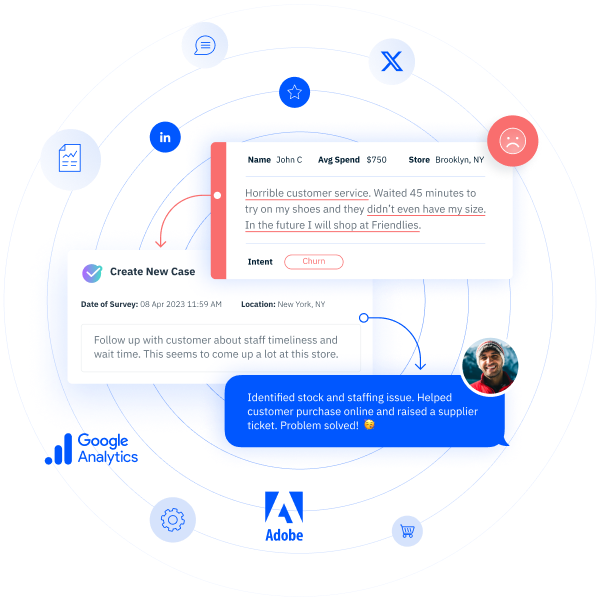What’s Holding Back Post-Call Survey Participation? Insights, Solutions, and Alternatives
Low post-call survey participation can hurt your CX strategy. Find out why it’s happening and what alternatives can drive better response and insight.
Post-call surveys have long been a staple in customer experience (CX) programs and contact center strategies. They’re a familiar way to gather immediate feedback after a customer interaction, often used to measure agent performance, track Net Promoter Score (NPS), and capture real-time customer sentiment. But here’s the challenge: response rates are dwindling.
Customers are becoming increasingly selective about when, where, and how they provide feedback. And in today’s omnichannel world—where a customer might start on a website, move to a chat, then escalate to a call—the idea that a single interaction tells the whole story simply doesn’t hold up.
So, what’s causing the drop in participation? Are post-call surveys still worth the effort? And how can CX leaders rethink their approach to ensure feedback is not just collected—but representative, actionable, and valuable?
Let’s break it down.
Are post-call surveys still relevant? Unpacking the pros and cons
Post-call surveys still remain one of the most direct ways to hear from your customers and gather data that can drive both short- and long-term improvements.
But as customer journeys grow more complex, relying solely on post-call surveys can lead to blind spots. The truth is that they are most effective when paired with broader feedback strategies that meet customers where they are.
Let’s look at both sides.
Pros
- 1. Capture Immediate Feedback
Post-call surveys provide immediate insight into how a customer feels after an interaction. That timeliness means you can respond faster to service failures or follow up on emerging issues before they escalate. - 2. Gain a Direct Measurement of Core CX Metrics
Post-call surveys are one of the most effective ways to measure standardized metrics like Customer Satisfaction (CSAT), Net Promoter Score (NPS), and Customer Effort Score (CES). These benchmarks help track performance over time and can tie directly to revenue or retention models. - 3. Get Agent-Level Insight
With the right setup, post-call feedback can be linked to individual agents, allowing managers to coach more effectively, recognize top performers, and identify training opportunities. - 4. Ask Specific Targeted Questions
Unlike unsolicited feedback, post-call surveys allow you to ask precise questions about the call experience—whether that’s about resolution, agent empathy, or call handling time.
Cons
- 1. Low Participation Rates
Industry averages suggest that post-call survey response rates often hover between 5–10%—meaning most voices are never heard. - 2. Bias in Who Responds
The customers who do respond often fall into two buckets: those who had an exceptional experience, and those who are frustrated or angry. That leaves a large group of neutral or moderate experiences unaccounted for, skewing your data. - 3. Survey Fatigue
Customers are bombarded with requests for feedback across channels. If your survey is too long, too repetitive, or poorly timed, it will get ignored. - 4. It Doesn’t Capture the Whole Journey
A phone call might be just one stop on a customer’s journey. Focusing solely on the call risks missing upstream or downstream issues that shaped their overall experience.
Common barriers to post-call survey participation
Understanding the obstacles hindering survey participation is crucial for developing effective strategies. Here are the most common roadblocks:
Survey fatigue and customer overload
Customers are inundated with feedback requests across various platforms, leading to survey fatigue. This constant bombardment diminishes their willingness to engage, resulting in lower response rates.
Poor timing and delivery method
Surveys sent too soon may catch customers off-guard, while delayed surveys risk being overlooked. Additionally, the choice between channels like Interactive Voice Response (IVR), email, or SMS can influence accessibility and convenience.
Lack of incentive or perceived value
Customers may disregard surveys if they perceive no personal benefit or doubt that their feedback will lead to tangible changes. Without a clear value proposition, engagement declines.
Impersonal or generic messaging
Generic survey invitations fail to resonate with customers. Lack of personalization can make the survey feel less relevant and even come across as spam.
Lengthy or irrelevant questions
Surveys that are too long or contain irrelevant questions can frustrate respondents, leading to incomplete responses or abandonment.
Strategies to improve post-call survey participation
Many organisations struggle to get customers to stick around and share their thoughts after a call. A few simple changes can make a big difference. Below are some tried-and-tested strategies to boost participation—and make sure you’re hearing from more of the voices that matter.
1. Optimize timing and channel selection
Selecting the appropriate moment and medium for survey delivery enhances visibility and completion rates. For instance, sending a brief SMS survey shortly after the call can capitalize on the recency of the interaction, making it more likely for customers to respond.
2. Personalize the ask
Make every survey feel like a thoughtful conversation, not a checkbox exercise. Create survey invitations that feel personal and authentic, reflecting the individual’s unique experience. Thoughtful personalization can make all the difference in driving higher engagement.
3. Keep it short and focused
Limit the number of questions and ensure they are directly relevant to the customer’s recent interaction. This approach reduces friction and the likelihood of survey abandonment.
4. Show customers their feedback matters
Demonstrate how customer input has led to tangible improvements. Closing the feedback loop fosters trust and encourages continued participation.
5. Consider incentives carefully
Our blog on Survey Response Incentives, explores how offering the right incentive can significantly boost participation—without skewing your results. Small, thoughtful incentives often strike the right balance without introducing bias or compromising data quality.
Going beyond post-call surveys with conversational intelligence
While post-call surveys provide valuable insights, they capture only a fraction of the customer experience. Conversational intelligence offers a more comprehensive view by analyzing 100% of customer interactions across channels.
- Omnichannel Voice of Customer: By capturing feedback from various touchpoints—calls, chats, emails—organizations gain a holistic understanding of the customer journey.
- AI-Driven Text Analytics: Advanced text analytics can uncover patterns and sentiments in customer communications, revealing insights that traditional surveys might miss.
- AI Summarization: Automated summarization of interactions enables quick identification of key issues and trends, facilitating faster decision-making
- Impact Prediction: Predictive analytics can assess the potential impact of identified issues, helping prioritize actions that will most improve the customer experience.
Transforms post-call feedback collection with InMoment
Low participation doesn’t mean post-call surveys are obsolete—but it does mean they need to evolve. The most effective CX programs combine multiple listening methods, tap into unsolicited feedback, and use analytics to turn raw input into action.
It’s time to stop chasing surveys and start listening smarter. Our Integrated CX platform combines surveys, conversational intelligence, and reputation insights to give you the full picture—not just a snapshot. It’s time to stop chasing surveys and start listening smarter.
Find out how we can help your organization and request a demo today.






